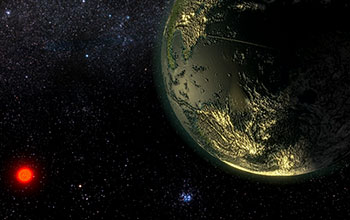Multimedia Gallery
Huge dataset of nearby stars available to public
A team of researchers has released the largest collection of observations made with a technique called radial velocity, to be used for hunting exoplanets.
More about this image
A team of researchers that includes the Massachusetts Institute of Technology (MIT) and is led by the Carnegie Institution for Science has released the largest collection of observations made with a technique called radial velocity, to be used for hunting exoplanets. The huge dataset, taken over two decades by the W.M. Keck Observatory in Hawaii is now available to the public, along with an open-source software package to process the data and an online tutorial. The researchers hope that by making the data public and user-friendly, it will draw fresh eyes to the observations, which encompass almost 61,000 measurements of more than 1,600 nearby stars.
"This is an amazing catalog, and we realized there just aren’t enough of us on the team to be doing as much science as could come out of this dataset," says Jennifer Burt, a Torres Postdoctoral Fellow in MIT’s Kavli Institute for Astrophysics and Space Research. "We’re trying to shift toward a more community-oriented idea of how we should do science so that others can access the data and see something interesting."
After taking a look through the data themselves, the researchers have detected over 100 potential exoplanets, including one orbiting GJ 411, the fourth-closest star to our solar system.
The newly available observations were taken by the High Resolution Echelle Spectrometer (HIRES), an instrument mounted on the Keck Observatory’s 10-meter telescope at Mauna Kea in Hawaii. HIRES is designed to split a star’s incoming light into a rainbow of color components. Scientists can then measure the precise intensity of thousands of color channels, or wavelengths, to determine characteristics of the starlight.
The research was supported in part by the National Science Foundation.
To learn more about this research, see the NSF News From the Field story Scientists make huge dataset of nearby stars available to public. (Date image taken: unknown; date originally posted to NSF Multimedia Gallery: Sept. 13, 2018)
Credit: Ricardo Ramirez/MIT
See other images like this on your iPhone or iPad download NSF Science Zone on the Apple App Store.
Special Restrictions: This image from the MIT News office website is made available to non-commercial entities, the press and the general public under a Creative Commons Attribution Non-Commercial No Derivatives license. You may not alter this image other than to crop it to size. A credit line must be used when reproducing this image. Direct questions to Abby Abazorius at the MIT News Office by email at abbya@mit.edu, or by phone at 617-253-2709.
Images and other media in the National Science Foundation Multimedia Gallery are available for use in print and electronic material by NSF employees, members of the media, university staff, teachers and the general public. All media in the gallery are intended for personal, educational and nonprofit/non-commercial use only.
Images credited to the National Science Foundation, a federal agency, are in the public domain. The images were created by employees of the United States Government as part of their official duties or prepared by contractors as "works for hire" for NSF. You may freely use NSF-credited images and, at your discretion, credit NSF with a "Courtesy: National Science Foundation" notation.
Additional information about general usage can be found in Conditions.
Also Available:
Download the high-resolution JPG version of the image. (1.0 MB)
Use your mouse to right-click (Mac users may need to Ctrl-click) the link above and choose the option that will save the file or target to your computer.

